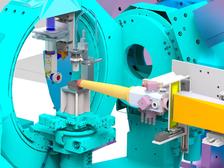The scientific case of the beamline concentrates on physics and chemistry of systems, dominated by low dimensional and confinement effects, with an emphasis on in-situ and operando methods.
Since 2023, the beamline access is organized through the novel Rolling Access scheme. Please consult the User Guide webpage for details, Rolling Access Proposals for PETRA III.
Before submitting an application, the users are strongly advised to contact the beamline responsible and clarify the technical feasibility and availability status of the equipment.
The beamline offers a variety of x-ray diffraction methods, such as reciprocal space mapping, x-ray reflectivity, resonant x-ray scattering, grazing incidence diffraction, x-ray standing waves. Other scattering and spectroscopy methods, e.g. powder diffraction and XANES, are also available with certain technical limitations. Accompanying secondary emission methods include x-ray fluorescence and optical luminescence detection.
P23 x-ray source is a spectroscopy type undulator providing up to 1013 photons in the core energy range 5 keV to 30 keV. Higher energies up to 50 keV can be also available for imaging methods. The x-ray optics consists of a double crystal monochromator, mirrors for harmonics rejection and beam collimation, and two groups of focusing lenses. The monochromator is equipped with Si(111) and Si(311) crystal pairs cooled with liquid nitrogen. The mirrors offer B4C, Pt and Rh surface coatings, which ensures operation in the whole energy range of the source. Beryllium focusing lenses in the optics hutch are designed for moderate 2:1 focusing, beam collimation and aperture matching operation in pair with the second lens changer in the experimental hutch. The latter can be positioned at variable distances 0.4 m - 2 m from the sample, thus providing, depending on the X-ray energy, a wide range of achievable beam spot sizes with demagnification factors down to 200:1.
A heavy load 5+2 circle Huber diffractometer in the experimental hutch can carry which can carry sample cells with up to 150 kg in horizontal scattering mode and up to 15 kg on an Eulerian cradle in the vertical mode.
The instrumentation available at the beamline is aimed for multiscale analysis of nanostructured materials and devices. The available detectors include a state of the art 2D LAMBDA pixel detector with GaAs sensor and a time resolution up to 2 kHz, an EIGER2 X 1M-W detector with CdTe sensor and a large area Xineos-2329 CMOS based flat panel detector. One can also use equipment and detectors from the PETRA sample environment and detector pools.
Another primary target of the beamline is to quickly and easily accommodate a widest variety of sample environments and experimental setups brought in by user groups.







